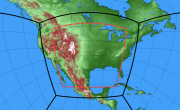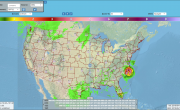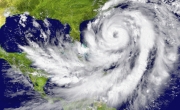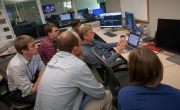Winter | The Community Leveraged Unified Ensemble, or CLUE, is an unprecedented collaboration between academic and government research institutions to help guide NOAA’s operational environmental modeling at the convection-allowing scale. The CLUE is produced during the annual NOAA Hazardous Weather Testbed (HWT) Spring Forecasting Experiment (SFE), where the primary goal is to document performance characteristics of experimental Convection-Allowing Modeling systems (CAMs). The HWT SFE is co-organized by NOAA’s National Severe… Read More
Director's Corner: NOAA’s emerging effort in community modeling
Ricky Rood, University of Michigan

Winter 2019 | I am the Co-chair, along with Hendrik Tolman, of the Unified Forecast System – Steering Committee (UFS-SC), one of the governance bodies in NOAA’s emerging community modeling effort. The overall goal of the UFS activity is to have a unified forecast system that can be configured to meet the many applications in NOAA’s product suite.
Who's Who: Tracy Hertneky
Winter | Tracy Hertneky "floats through the air with the greatest of ease" -- or does she? This daring young woman flying in an aerial silk (one of her many hobbies is being an aerialist - like in the Cirque du Soleil)-- doesn’t actually like to fly and requests the superpower to be able to teleport. She dreams of visiting places from New Zealand to Belgium (loves the beer) and the Summer Olympics! Plus, the ability to teleport would certainly be more efficient for travel and help in her role as a new mom to Juliet who was born… Read More
Bridges to Operations: Use of Model Evaluation Tools in NWS QPF Verification

Winter | The National Weather Service (NWS) Meteorological Development Laboratory (MDL) is developing an automated, nationally consistent and centralized service that verifies Quantitative Precipitation Forecasts (QPF). This QPF Verification Service (QPFVS) will provide objective assessments of the predictive skill of numerical model guidance and official NWS forecasts to help increase the accuracy of quantitative precipitation forecasts. QPFVS will be implemented as a component of a larger gridded verification system with… Read More
Visitors: Towards a better understanding of the vertical aerosol distribution in the atmosphere
Visitor: Barbara Scherllin-Pirscher
Winter | On 14 April 2010, increasing volcanic activity, including explosive eruptions, were observed at the Icelandic volcano Eyjafjallajökull. The volcano was largely unknown by the general public until then. On that particular day, however, the volcano started ejecting fine ash into the atmosphere, which was advected towards continental Europe. Major disruptions of the air traffic across western and northern Europe were necessary in order to ensure aviation safety. Several countries closed their airspace, affecting… Read More
Community Connections: The DTC helps the research community enhance the GSI/EnKF operational data assimilation system
Winter 2019 | Gridpoint Statistical Interpolation (GSI)/Ensemble Kalman Filter (EnKF) are operational data assimilation systems, open to contributions from scientists and software engineers from both operations and research. The development and maintenance of NOAA GSI/EnKF data assimilation systems are coordinated and managed by the Data Assimilation Review Committee (DARC), which incorporates all major GSI/EnKF data assimilation development teams in the United States within a unified community framework. DARC established a code… Read More
Did you know?: The Formal FV3GFS Evaluation
Winter | Implementing the GFS global model with the FV3 dynamic core upgrade into the National Centers for Environmental Prediction (NCEP) Production Suite will be the first step towards a Unified Forecast System (UFS). But prior to any new code being delivered to NCEP Central Operations, the NCEP Director must decide whether the implementation should occur, based on recommendations from the Environmental Modeling Center (EMC) and customers and stakeholders in the field at the conclusion of a formal evaluation period. EMC’s … Read More
Software Release: Community GSI version 3.7 and EnKF Version 1.3

2018-11-07 | The Developmental Testbed Center (DTC) is pleased to announce the release of the 2018 Community Gridpoint Statistical Interpolation (GSI) Version 3.7 and Ensemble Kalman Filter (EnKF) version 1.3 data assimilation system. This release includes the latest code as of October 30th of 2018, new compiling system, and updated run scripts with updated User's Guide and on-line tutorials. … Read More
Software Release: HWRFv4.0a Release

2018-11-05 | The DTC Hurricane team is pleased to announce the release of version 4.0a of the community HWRF modeling system. The release includes all components of the system: scripts, data preprocessing, vortex initialization, data assimilation, atmospheric and ocean models, coupler, postprocessor, and vortex tracker. Both the Scientific Documentation and the Users Guide have been updated. Users may go to http://www.dtcenter.org/HurrWRF/users to download codes, acquire datasets, and get information and documentation about HWRF.… Read More
Software Release: METplus 2.0 with MET 8.0 and METviewer 2.8 components

2018-09-28 | The Model Evaluation Tools (MET) development team at the DTC is pleased to announce the release of a multi-component verification capability called METplus. It includes METplus version 2.0, MET version 8.0 and METviewer version 2.8. METplus is a suite of Python wrappers and ancillary scripts to enhance the user's ability to quickly set-up and run MET. METviewer is a database and display system for aggregating and plotting MET output. In the future, a user will be able to check everything out through the METplus GitHub… Read More
Software Release: GMTB public release of CCPP v2.0

2018-08-30 | The DTC’s Global Model Test Bed (GMTB) is pleased to announce the public release of the Common Community Physics Package (CCPP) v2.0, containing a library of physical parameterizations (CCPP-Physics), and the framework that connects it to host models (CCPP-Framework). In this release, the CCPP has been bundled with the GMTB Single Column Model (SCM) v2.1, and contains updated physical parameterizations of the GFS suite plus the GFDL microphysics scheme. The CCPP has also been integrated with the experimental version of… Read More
Lead Story: Hierarchical Model Development and Single Column Models

Summer | Earth system models connect the atmosphere, ocean, and land, and depend on proper representations of dynamics and physics, initial conditions, and interactions of these processes to predict future conditions. Standard meteorological variables are used to validate typical numerical weather prediction models but are gross measures of these countless interactions and limit their usefulness for guiding model improvement. Some fraction of error in these metrics can be the result of specific physical parameterizations, but it can… Read More
Did you know?: The Next Generation Global Prediction System
Summer 2018 | The Next Generation Global Prediction System (NGGPS) multi-year Strategic Implementation Plan (SIP) connects federal and academic experts in the numerical weather prediction community to support the end-to-end functionality of the National Centers for Environmental Prediction (NCEP) Production Suite. The goal of the SIP is to help evolve the NGGPS into a Unified Forecast System (UFS) for operations and research. The SIP governance includes UFS Working Groups who represent the essential science, technical, and design… Read More
Director's Corner: NOAA Embraces Community Modeling to Advance Weather Prediction
Brian Gross, Acting Director EMC

Summer 2018 | NOAA and the National Weather Service (NWS) are embarking on a new strategy of community engagement for developing the numerical weather prediction models that provide NWS forecasters with the best possible guidance. By engaging the broader numerical modeling community, NWS will leverage the vast modeling expertise that resides therein, since each model developer offers a unique perspective about modeling challenges and possible solutions.
Pagination
Copyright © 2025. All rights reserved.
